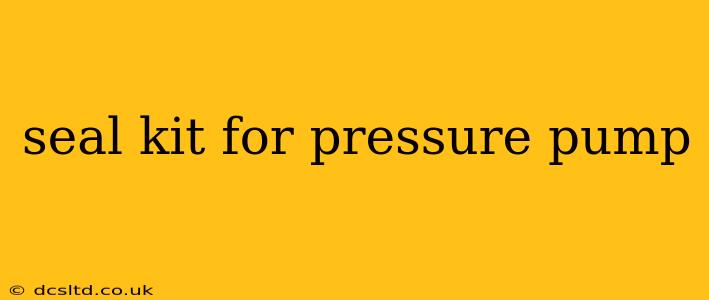Pressure pumps, vital components in various industries and household applications, rely on seals to maintain efficiency and prevent leaks. A failing seal can lead to costly downtime, fluid loss, and even equipment damage. Understanding seal kits for pressure pumps, their types, selection, and installation, is crucial for maintaining optimal performance. This comprehensive guide will delve into these aspects, answering common questions and providing valuable insights for both professionals and DIY enthusiasts.
What is a Seal Kit for a Pressure Pump?
A seal kit for a pressure pump is a collection of replacement seals designed to restore the pump's ability to contain pressure and prevent leaks. These kits typically include various types of seals, such as O-rings, lip seals, and shaft seals, tailored to the specific pump model. The exact contents vary depending on the pump's design and application. Choosing the correct kit is paramount; an incorrectly sized or inappropriate seal type will not resolve the leak and may even cause further damage.
What are the Different Types of Seals in a Pressure Pump Seal Kit?
Several seal types commonly feature in pressure pump seal kits. Understanding their differences is crucial for selecting the appropriate kit and performing the replacement correctly.
-
O-rings: These are simple, circular seals used to create a static seal between two surfaces. They are widely used in pressure pumps due to their effectiveness and cost-effectiveness.
-
Lip seals (Radial Shaft Seals): These seals are dynamic seals, meaning they prevent leakage while a shaft rotates. They are commonly found in pumps with rotating shafts.
-
Shaft seals (Mechanical Seals): These seals are more complex and durable than lip seals, often used in high-pressure, high-speed applications. They consist of multiple components working in conjunction to prevent leakage.
-
Cup seals: These are U-shaped seals offering a robust sealing solution for reciprocating or oscillating components within the pressure pump system.
-
V-packings: These consist of several rings of flexible material that conform to the shaft and create a seal as the shaft moves. They are commonly found in older pump designs.
The specific types of seals included in a kit depend heavily on the pump's manufacturer, model, and application.
How Do I Choose the Right Seal Kit for My Pressure Pump?
Selecting the correct seal kit is critical. Incorrect seals will not solve the problem and may cause further damage. Always refer to your pump's manufacturer's documentation for the correct part number or a detailed parts diagram. The documentation will specify the correct seal kit required for your particular model. If you cannot locate this information, contacting the manufacturer directly or a reputable pump repair specialist is recommended. Never attempt to guess the correct seals.
How Often Should I Replace the Seal Kit in My Pressure Pump?
The frequency of seal kit replacement varies depending on several factors:
- Pump usage: Frequent use naturally leads to faster wear and tear.
- Operating conditions: High pressure and temperature applications accelerate seal degradation.
- Fluid type: Aggressive fluids can damage seals more quickly.
- Maintenance practices: Regular inspections and preventative maintenance can prolong seal life.
While there's no universal timeframe, regular inspection for leaks or performance degradation is advisable. Addressing issues promptly can prevent costly repairs down the line.
Can I Replace a Seal Kit Myself?
Replacing a seal kit can be a straightforward task for some pumps, while others require specialized tools and expertise. Always refer to the manufacturer's instructions before attempting any repairs. Improper installation can lead to damage to the pump and potentially injury. If you're unsure about your abilities, seek the assistance of a qualified pump technician. The cost of professional repair might be less than the cost of replacing a damaged pump due to incorrect DIY repair.
What Happens If I Don't Replace a Failing Seal?
Ignoring a failing seal can have significant consequences:
- Fluid leakage: Leading to fluid loss, environmental damage, and operational inefficiency.
- Reduced pump efficiency: Leakage reduces the pump's ability to generate pressure, impacting its performance.
- Pump damage: Continued operation with a failing seal can lead to catastrophic pump failure.
- Safety hazards: Depending on the fluid being pumped, leakage can create hazardous conditions.
Where Can I Find Seal Kits for Pressure Pumps?
Seal kits for pressure pumps are usually available from various sources, including:
- Pump manufacturers: Often the best source for original equipment manufacturer (OEM) parts.
- Industrial supply stores: Carry a wide range of pump parts and seals.
- Online retailers: Offer a vast selection, but verify compatibility before purchasing.
- Pump repair specialists: They can assist in identifying and sourcing the correct parts.
By carefully following this guide, users can better understand, choose, and utilize pressure pump seal kits to maintain their equipment effectively. Remember to prioritize safety and always refer to the manufacturer's instructions before undertaking any repair work.
